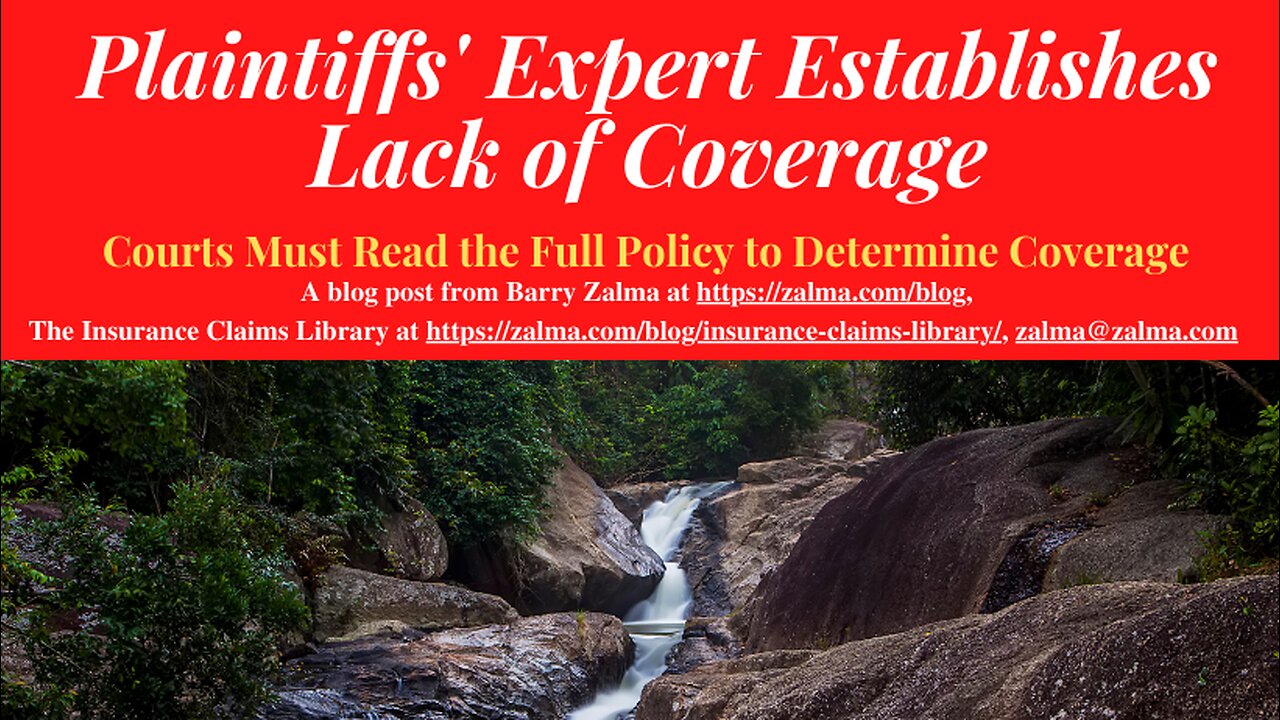Premium Only Content

Plaintiffs' Expert Establishes Lack of Coverage
Courts Must Read the Full Policy to Determine Coverage
Plaintiffs Joshua and Rachel Dow purchased their home at 1017 Moss Creek Drive in Hurricane, WV in March of 2018. This property is contiguous to the Valley Park Wave Pool. After Plaintiffs purchased the home, they entered into a contract for first party insurance with Defendant Liberty Insurance Company. As of June 2018, Plaintiffs noticed water entering their property and leaking into the crawl space of their home.
In Joshua Dow and Rachel Dow v. Liberty Insurance Company, Civil Action No. 3:19-0486, United States District Court, S.D. West Virginia, Huntington Division (December 1, 2022) the Plaintiffs sued their insurer who refused to pay their claim and the District Court dealt with the issue of coverage for damage caused by the water entering their property.
BACKGROUND
The water flowed from the edge of a ditch on an adjoining property into their yard. This ditch ended 2030 feet from Plaintiffs' property and had carried water downhill toward the river for several years, even before the nearby Wave Park was built. For many years, this ditch carried water without damaging Plaintiffs' home. However, the Putnam County Commission built a maintenance building on the property at the Wave Park in 2018, which raised the elevation of the land. Construction on the maintenance building ended in March of 2018. Because of the elevation change, heavy rain and water problems at the Wave Park overwhelmed the ditch and forced water into Plaintiffs' yard, which entered the crawl space of their home.
Liberty's Claims Specialist was advised that the County was in litigation over the matter and would not discuss anything with the insurer. Defendant formally denied the claim November 28, 2018. In the denial email, the Claims Specialist said that the claim was denied because water had “traveled through the ground,” which was excluded under the policy.
Defendant attached a full copy of Plaintiffs' policy to their Motion to Dismiss. The full policy excluded “Flood, surface water, waves, tidal water, overflow of a body of water, or spray from any of these, whether or not driven by wind; (2) release of water held by a dam, levee, dike or by a water or flood control device or structure; b. Water below the surface of the ground, including water which exerts pressure on or seeps or leaks through a building, sidewalk, driveway, foundation, swimming pool or other structure.”
Plaintiffs sued. An engineering expert retained by the Plaintiffs opined that the topography as it currently lays forces and directs the water from this water course onto the Plaintiffs property and into the crawl space of the Plaintiffs' home.
DISCUSSION
Inherent in the claims is the issue of whether the damage sustained by Plaintiffs is covered by the terms of the policy. When a policyholder shows that a loss occurred while an insurance policy was in force, an insurance company seeking to avoid liability through the operation of an exclusion has the burden of proving the facts necessary to the operation of that exclusion. The insurer must also prove that the allegedly applicable exclusion is valid, unambiguous, and substantiated.
Validity of the Water Damage Exclusion
Defendant specifically identified additional exclusions that would further limit the number of cognizable water damage claims. Further, there already existed a broad exclusion for water damage in the base policy, demonstrating Defendant's intent to widely exclude coverage for water damage in its insurance policies. Although Defendant omitted the particular phrase “water control device or structure” from its Summary filing, it is essentially synonymous with the specifically stated sources of water damage, such as “dam,” “levee,” and “dike,” and the court concluded that the exclusion utilized by Defendant to preclude coverage for the water damage to Plaintiffs' home is valid.
Ambiguity of the Water Damage Exclusion
A court interpreting an insurance policy should give the language of the policy its plain, ordinary meaning. Where the words of the policy are clear and unambiguous, it is not the role of the court to judicially construct or interpret meaning, but rather, give full effect to the plain meaning intended.
It was clear to the Court that the plain, ordinary meaning of the words leaves the meaning of this exclusionary policy language clear. First, the reference to a “water device or structure” must be read in conjunction with the other, specific terms in the exclusion: “dam,” “levee,” and “dike.” Standing alone, the phrase “water control device or structure” may be ambiguous, but the Court must read the phrase in the context of the entire exclusionary provision, including the underlying base policy's water damage exclusion.
Since Plaintiffs' expert described the water damage to Plaintiffs' home resulting from water flowing from upland of Plaintiffs' property the channel was designed to capture water on the hillside and control it. The purpose of its creation was to gather the water into the watercourse to stop it from inundating the surrounding properties. It was clear to the District Court that the water course described by Plaintiffs' expert is a “water control device or structure.” The water causing the damage is external to Plaintiffs' property; it was channeled and controlled; and ultimately, it was released from the watercourse and damaged Plaintiffs' property.
Defendant Proving Facts
The fact that it is Plaintiffs' expert's testimony that supports the exclusion of coverage has no bearing on the application of that testimony to the analysis of summary judgment. The Court can, and properly did, consider Plaintiffs' expert testimony, and the expert testimony supported the exclusion of coverage.
This Court was sympathetic to Plaintiffs and the hardships they've experienced due to the damage to their property. Unfortunately for the plaintiffs, coverage for these water damages was not afforded under their insurance policy.
ZALMA OPINION
RTFP: Read the Full Policy is the key to the interpretation of an insurance contract. The court did so and applied the full policy and its meaning was clear when read in its entirety. The case established that it is improper to try to change the meaning of a policy by taking a part of the policy out of context and ignoring the full wording of the exclusion and the policy.
(c) 2022 Barry Zalma & ClaimSchool, Inc.
Subscribe and receive videos limited to subscribers of Excellence in Claims Handling at locals.com https://zalmaoninsurance.locals.com/subscribe.
Go to substack at substack.com/refer/barryzalma Consider subscribing to my publications at substack at substack.com/refer/barryzalma
Barry Zalma, Esq., CFE, now limits his practice to service as an insurance consultant specializing in insurance coverage, insurance claims handling, insurance bad faith and insurance fraud almost equally for insurers and policyholders. He practiced law in California for more than 44 years as an insurance coverage and claims handling lawyer and more than 54 years in the insurance business. He is available at http://www.zalma.com and zalma@zalma.com
Write to Mr. Zalma at zalma@zalma.com; http://www.zalma.com; http://zalma.com/blog; daily articles are published at https://zalma.substack.com. Go to the podcast Zalma On Insurance at https://anchor.fm/barry-zalma; Follow Mr. Zalma on Twitter at https://twitter.com/bzalma; Go to Barry Zalma videos at Rumble.com at https://rumble.com/c/c-262921; Go to Barry Zalma on YouTube- https://www.youtube.com/channel/UCysiZklEtxZsSF9DfC0Expg; Go to the Insurance Claims Library – https://zalma.com/blog/insurance-claims-library
-
 7:40
7:40
Barry Zalma, Inc. on Insurance Law
11 months agoLoss of Inventory by Bankruptcy
150 -
 58:10
58:10
Kimberly Guilfoyle
23 hours agoAmerica is Back & The Future is Bright: A Year in Review | Ep. 183
164K68 -
 3:03:27
3:03:27
vivafrei
1 day agoEp. 242: Barnes is BACK AGAIN! Trump, Fani, J6, RFK, Chip Roy, USS Liberty AND MORE! Viva & Barnes
241K240 -
 2:05:48
2:05:48
2 MIKES LIVE
4 hours agoTHE MIKE SCHWARTZ SHOW with DR. MICHAEL J SCHWARTZ 12-24-2024
21K1 -
 1:14:17
1:14:17
MTNTOUGH Fitness Lab
1 day agoNavy SEAL Dom Raso: The Cold, Hard Truth About Modern Brotherhood | MTNPOD #96
16.4K2 -
 43:42
43:42
Dad Dojo Podcast
20 hours agoEP14: Every Girl Dad's Biggest Fear and How To Prevent It
11K -
 55:06
55:06
Bek Lover Podcast
13 hours agoWill Trump Pull Off A Miracle? Other Strange News Podcast...
9.42K7 -
 55:53
55:53
PMG
1 day ago $0.01 earned"Hannah Faulkner and Courtney Reed | BEHIND THE LENS OF A TRUMP PHOTOGRAPHER"
7.88K -
 8:09:50
8:09:50
Dr Disrespect
1 day ago🔴LIVE - DR DISRESPECT - MARVEL RIVALS - GOLD VANGUARD
228K38 -
 1:15:00
1:15:00
Awaken With JP
1 day agoMerry Christmas NOT Happy Holidays! Special - LIES Ep 71
312K262